3.3: Roots
- Page ID
- 93155
By the end of this lesson you will be able to:
- Locate and identify characteristics of the primary root, lateral or secondary roots, and root hairs.
- Distinguish two major types of root systems and how they develop.
Roots
The general perception is that roots are the parts of the plant that are found in the soil. While this is typically true, there are exceptions, just as there are with the notion that all shoots are above ground. To recognize roots, we’ll look at more than whether or not they are in the soil.

Unlike stems and branches, roots don’t have a node/internode pattern of construction. There are no nodes, no internodes, no leaves, and no branching from regular spots, as you find with stems and branches. Roots do have structures but, in contrast to stems and branches, these structures emerge irregularly from the root according to where they are needed, and to some extent according to inherited tendencies, rather than emerging at specific zones the way leaves, branches, and inflorescences emerge from nodes on the stem.
Watch this video for a short intro to roots.
Purposes of roots
Anchorage
Roots keep the plant moored to the soil in a particular place. This “anchorage” not only facilitates other functions for the plant, but provides a benefit for the soil. An extensive root system helps hold the soil in place so that it is less likely to be eroded by wind or rain. Where there are roots the soil tends to be retained. No roots, and the soil easily gets washed or blown away. On the flip side, if conditions are poor the plant can’t pull up roots and move somewhere else where prospects for growth are better.
Support
The roots, particularly the tap root that we examine below, provides the foundation for upright growth.
Absorption
Roots are the structure of the plant that absorb water and soluble nutrients..
Symbiotic interaction with other organisms
Roots of plants from the taxonomic family Fabaceae — which are commonly called legumes, and include plants like peas, beans, clover, and locust trees — can form a symbiotic relationship with Rhizobia bacteria. This results in nitrogen fixation, which allows for the conversion of nitrogen from the atmosphere into nitrogen compounds that the plant can use to produce proteins and other building-block molecules. For nitrogen fixation to occur, rhizobia require a plant host; they cannot independently fix nitrogen. These bacteria fix nitrogen after becoming established inside root nodules of plants in the Fabaceae family.
Roots also develop associations with Mycorrhizal fungi. In contrast to the Rhizobia bacteria, which only symbiotically interact with a narrow range of plants, Mycorrhizae (mycorrhizae is the plural of mycorrhiza) are fungi that grow in association with roots of a wide range of plants — perhaps most plants. The mycorrhizae help acquire phosphorus from the soil and make it available to the plants’ roots. Mycorrhiza may also enhance water uptake.
Watch this video about symbiotic relationships between roots and soil organisms.
Nutrient storage
Roots of some plants can swell and store high-energy compounds like starch and sugar. Examples include carrots, beets, sweet potato — but not white potato. Roots also store some protein and other nutrients, but the focus is typically on high-energy carbohydrates.
- What external features clearly differentiate roots from stems?
- What purposes do roots serve beyond absorption of water and nutrients?
- What are two examples of living organisms that symbiotically interact with roots? How do they differ in terms of the plants they infect and the benefits they provide?
Root systems
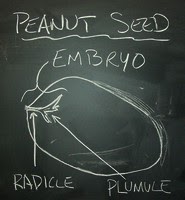
A plant’s root originates in the embryo formed within the seed. The section of the embryo that is root tissue is called the radicle (note the spelling). At the tip or apex of the radicle is a region of rapid cell division and growth called an apical meristem (you may recall that shoots have an apical meristem too). As a result of the apical meristem’s rapid cell division, the radicle grows down into the soil. The root that forms from the embryonic radicle is called the primary root. This sketch of half of a peanut seed shows the radicle that is part of the embryo inside the seed. The plumule is the embryonic shoot.
Shortly after germination and establishment of the seedling, plants generally develop one of two types of root systems: tap root or fibrous root.

Watch this video to see the differences between tap roots and fibrous roots.
Tap root systems
The tap root is persistent, meaning that it is retained throughout the life of the plant; it is also defined as a strong primary root that grows downward into the soil. This tap or primary root is the central axis off of which lateral or secondary roots branch in irregular patterns in response to the availability of high-quality soil — soil with adequate moisture, nutrients, and favorable soil structure (proper particle aggregation and pore space that fosters gas exchange and moisture retention).
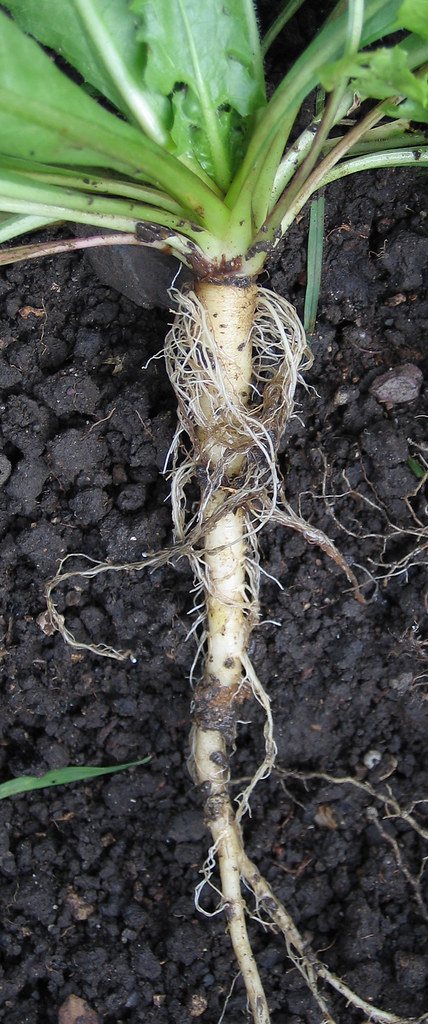
Lateral or secondary roots typically grow relatively parallel to the soil surface, while the primary or tap root grows perpendicular to the soil surface. Tertiary roots branch off of secondary roots, again in response to nutrient and moisture availability.
A tap root system provides strong leverage and anchorage in the soil. If firmly connected to an upright stem, the tap root can resist uprooting by wind whipping at the shoot and herbivores yanking on the leaves and branches. Both the pigweed and the velvetleaf pictured here are tall, upright plants. The strong taproot helps provide the underground leverage to hold those plants upright.
Fibrous root systems
Fibrous root systems begin the same as tap root systems…with a radicle growing from the seed. However, after a period of early growth, the radicle or primary root stops growing (or slows its growth) and roots begin to form from the stem tissue that is underground, but just above the primary root. These roots emerging from stem tissue are adventitious roots — indicating that the roots emerge from the main stem.

In beans there are two types of adventitious roots. The roots that emerge from the region just above where the main stem stops and the root begins are called basal roots (basal because they are at the base of the main stem). The roots that emerge above these basal roots are called hypocotyl roots. As we’ll see in a later chapter, the portion of the stem just above the root-shoot transition zone is called the hypocotyl. Adventitious roots that contribute to the fibrous root system stay close to the soil surface. Fibrous root systems are excellent at holding soil in place because they are thin, extensive, and weblike. This is why various types of grasses, which have fibrous root systems, are planted in areas that are subject to erosion from flowing water following rains. The fibrous root systems of the grasses, once established, hang on to the soil particles like a web of very thin, interlaced fingers.
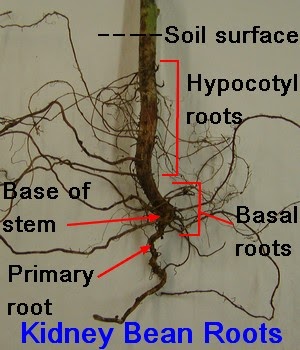
The kidney bean root system pictured above has been growing for a few weeks. You can identify the soil line on the stem by where the stem coloration transitions from green to cream or buff color. The root doesn’t start immediately after the stem enters the soil. Instead, the stem continues underground for about an inch. Notice the point where the width of the stem drastically reduces; this is where the primary root tissue starts. Again, the primary root traces directly back to the radicle, which is part of the embryo in the seed. Just above where the root starts are the basal roots, and above these are the hypocotyl roots. As noted above, basal and hypocotyl roots are adventitious roots, as they emerge from the stem.
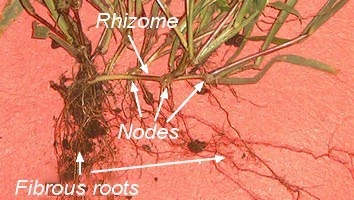
In this picture of Echinopogon ovatus, known as hedgehog grass in its native Australia, you can see the rhizome or underground stem that is typical of spreading grasses. Note the nodes on the rhizome, which indicate that it is shoot tissue, not root tissue. Also note that the roots emerging from these nodes. The roots are adventitious because they emerge from shoot tissue rather than from the primary root (which disintegrates early in the growth of grasses). Shoot tissue often also emerges from these nodes.
Both tap root systems and fibrous root systems rely on root hairs to gather moisture and nutrients. Root hairs are extensions of the outer layer of cells (called the epidermis) of young roots. Root hairs live for only a few weeks, deteriorate, and are then replaced by fresh root hairs.
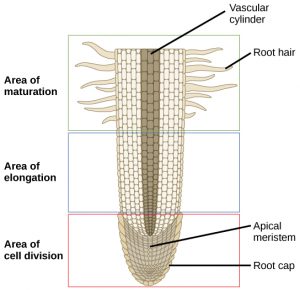
Corn (below) provides another example of adventitious roots. In this case, the roots are formed from shoot tissue above the soil and then angle down toward the soil. These are the “brace” or "prop" roots of corn. Sometimes they reach the ground, and other times they hang in the air. The roots that reach the soil branch extensively and are important for moisture and nutrient absorption. Below is a photo of the adventitious brace roots of Prunella vulgaris.
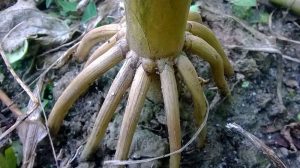
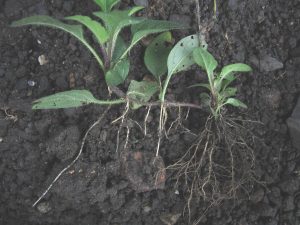
- What is the difference between a tap root system and a fibrous root system?
- From what cells on young roots do root hairs form?
- What is the radicle? Does it persist in all mature plants?


